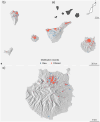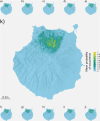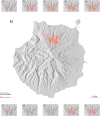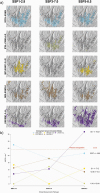Present and Future of the White-Tailed Laurel Pigeon (Columba junoniae) on Gran Canaria Island
- PMID: 40546914
- PMCID: PMC12181689
- DOI: 10.1002/ece3.71580
Present and Future of the White-Tailed Laurel Pigeon (Columba junoniae) on Gran Canaria Island
Abstract
Due to their evolutionary history and restricted distribution islands species are particularly vulnerable to human impacts and extinction. Consequently, many islands' species have been extirpated, causing complete or local extinctions. Reintroductions are useful, although challenging, tools to restore ecosystems and halt biodiversity loss. In this work, we evaluate the reintroduction success of the endemic white-tailed laurel pigeon (Columba junoniae) on the island of Gran Canaria. We also explore its future potential distribution under different scenarios of climate change in the Canary Islands (Spain). We used a combination of Maximum Entropy models (MaxEnt), trained with spatial records within the whole range of the species, to model the potential distribution of C. junoniae on the island of Gran Canaria, where it was recently reintroduced. We compared this potential distribution with the actual distribution of the species in the reintroduction area. Furthermore, we used multiple scenarios of climate change to analyze the likely changes in the species' suitable habitat. We found that C. junoniae has colonized most of its potential habitat in the new reintroduction area. Overall, this marks that the reintroduction has successfully facilitated the spread and settlement of the species. However, our analysis also showed that this habitat is expected to suffer future fragmentations and contractions under different climate change scenarios. Based on our research, C. junoniae has colonised most of its potential habitat within its new distribution area. Although this is a huge milestone for the conservation of the species, future changes might jeopardise the species' future. In this scenario of accelerated environmental change, microhabitats and niche refuges can alleviate this situation. Our results also suggest that restoration of native forests is fundamental to ensure the species' long-term persistence and ecosystems' resilience against climate and land-use changes. This work sets the principles for the evaluation of the reintroduction of C. junoniae in Gran Canaria, as well as the long-term conservation strategy for the species in its new distribution area.
Keywords: birds; climate change; conservation; conservation evaluation; islands; management; reintroduction.
© 2025 The Author(s). Ecology and Evolution published by British Ecological Society and John Wiley & Sons Ltd.
Conflict of interest statement
The authors declare no conflicts of interest.
Figures





References
-
- Armstrong, D. P. , McArthur N., Govella S., et al. 2013. “Using Radio‐Tracking Data to Predict Post‐Release Establishment in Reintroductions to Habitat Fragments.” Biological Conservation 168: 152–160. 10.1016/j.biocon.2013.09.028. - DOI
-
- Beck, J. , Böller M., Erhardt A., and Schwanghart W.. 2014. “Spatial Bias in the GBIF Database and Its Effect on Modeling Species' Geographic Distributions.” Ecological Informatics 19: 10–15.
-
- Benayas, J. M. R. , Newton A. C., Diaz A., and Bullock J. M.. 2009. “Enhancement of Biodiversity and Ecosystem Services by Ecological Restoration: A Meta‐Analysis.” Science 325, no. 5944: 1121–1124. - PubMed
-
- Booth, T. H. 2018. “Why Understanding the Pioneering and Continuing Contributions of BIOCLIM to Species Distribution Modelling Is Important.” Austral Ecology 43, no. 8: 852–860. 10.1111/aec.12628. - DOI
LinkOut - more resources
Full Text Sources

